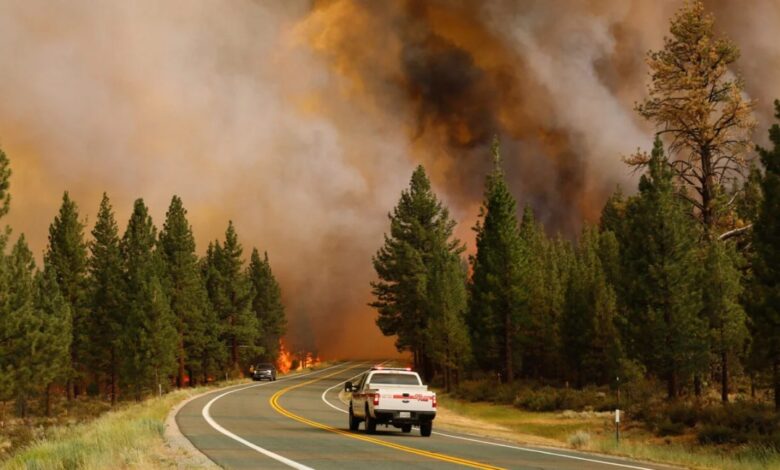Will Your COVID-19 Mask Protect You from Wildfire Smoke?

- Health experts say an N95 mask is your best bet for protecting yourself from both the novel coronavirus and wildfire smoke.
- Research shows KN95 masks are just as effective.
- While surgical masks became popular during the COVID-19 outbreak, they are not effective at protecting against wildfire smoke
The 2023 wildfire season has just started and severe fires in Canada has meant that smoke is impacting the East Coast of the U.S.
In New York the air quality for most of the states is expected to be unhealthy for sensitive groups due largely to these fires.
Exposure to smoky air comes with negative health consequences, causing an uptick in asthma attacks, visits to the emergency room, and inflammation throughout the body. A well-made face mask will not only protect you from the highly contagious Delta variant but also from the harmful chemicals in wildfire smoke as well.
With all the different types of masks out there, it can be tricky to figure out which type, if any, can keep you safe from the hazardous particles in smoky air and other people’s respiratory droplets.
Here’s a guide to finding a mask that can keep you safe from wildfire smoke.
The mask that offers the most protection against both the novel coronavirus and wildfire smoke is the N95 mask.
If fitted and worn correctly, the N95 mask filters out 95% of particles larger than 0.3 microns, so they’re very efficient with keeping out the 2.5-micron particles in wildfire smoke, according to Dr. William Lang, the chief medical officer at WorldClinic and a former director of the White House Medical Unit.
“Infection generally requires that the virus is carried by some other particle, so respirators that… filter particulates do effectively reduce viral exposure,” Lang said in an earlier interview, noting that this is why the N95 mask is effective at protecting people against viral infection.
N100 or P100 filters keep out 99.97% of these same particles but can make breathing difficult, Lang adds.
“N95 masks are the type of face covering protection that I would recommend for somebody who is outside during the air pollution caused by wildfires,” Marina Vance, an assistant professor in the department of mechanical engineering and in the environmental engineering program at the University of Colorado, Boulder, told Healthline in an earlier interview.
If you have an N95 mask with a valve, Vance recommends putting something on top of the valve, like a cloth mask, or sealing it off to protect others around you from your respiratory droplets.
Vance also recommends using the mask just a few times, then tossing it. In some cases — like when the conditions are hazardous — it may be best to use it once and toss it. N95 masks are not meant to be reused, and with each use or clean, they become less effective.
“A lot of people are reusing their N95s and trying to disinfect them, and that will cause a reduction in efficiency,” said Vance. If the mask is starting to develop cracks or looks wrinkly, it’s no good.
If you’re having a hard time getting an N95 mask, the good news is that KN95 masks can work just as well.
They’re very efficient at filtering out particulate matter, according to Vance. The only difference between N95 and KN95 masks is the standards used to test efficiency, as KN95s are produced by different countries.
Vance and her colleagues have been testing N95 and KN95 masks in their lab and have found that both have very high filtration efficiency.
“These are both very efficient masks; I would trust them both,” Vance told Healthline.
Smoke from wildfires can be in high in PM2.5, which indicates how many particles sized 2.5 microns and under are floating in the air we breathe.
Particles that size can be inhaled into the lungs and create a host of health issues including increased risk of asthma attacks, stroke or heart attack.
Exposure to high amounts of smoke can quickly result in symptoms such as itchy or irritated eyes, coughing, chest pain, irrirated sinuses, wheezing and a fast heart beat, according to the
Your standard cloth mask isn’t going to offer much protection when it comes to wildfire smoke. “When it comes to wildfires, the story is completely different,” Vance said.
Wildfire smoke particles are much smaller — about 10 to 100 times tinier — than respiratory droplets, according to Vance.
Cloth masks aren’t able to efficiently filter out these hazardous particles. They also often have gaps on the sides and around the nose where polluted air can seep in, be inhaled, and get into your lungs. They’re beneficial but not as good as an N95 mask, says Lang.
The structure and type of fabric the cloth mask is made of matter. Colorado State University recently published research on what type of materials make the most effective face mask.
Dual and triple-layer woven cotton masks are better at filtering out particles, compared with other fabrics. “When you’re talking about fabrics, you want something that has tightly woven, nonstretchy material and multiple layers of it rather than a single layer,” Vance said.
You can also buy a filter — like a furnace filter or MERV 13 filter — and build it into your cloth mask.
Vance recommends ensuring the filter is layered within the entire mask, rather than just part of the mask.
A well-built cloth mask with a center filtering layer can substantially lower your risk, says Lang.
If you’re in an area with poor air quality, it’s best to stay inside.
“If you don’t have to be outdoors, stay indoors,” said Lang.
Look at the local air quality index (AQI) on a site like AirNow or PurpleAir. If the AQI ranges from moderate to hazardous, avoid going outside. A mask should really be worn if the AQI is higher than 100, Vance says.
It’s also wise to reduce any opportunities for the air to creep inside — close your windows and doors and consider sealing off any potential air leakage sites. “A lot of the outdoor pollution eventually makes it indoors and affects the indoor (air) quality,” Vance said.
Vance recommends purchasing an inside air purifier that contains HEPA filters. Avoid ionic air filters, Vance says, as they may actually produce some byproducts that you don’t really want to breathe in.
The DIY box filter solution — which can be made quickly with a box fan, a filter, and duct tape — is another good, more affordable option, says Vance.
“Some people will continue to experience difficulties even with filtered air indoors, as filters do not ‘purify the air,’ only reduce the concentration of particles,” said Lang.
If you try these methods out and your respiratory system is still irritated, “The best approach is to leave the downwind areas until the fire is controlled or the winds change,” Lang said.
Health experts say an N95 mask is your best bet for protecting yourself from both the novel coronavirus and wildfire smoke.
Research shows KN95 masks can be just as effective. Cloth masks, though effective at protecting yourself and others from COVID-19, aren’t going to offer much safety from the hazardous particles produced by wildfire smoke.




